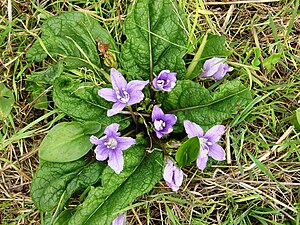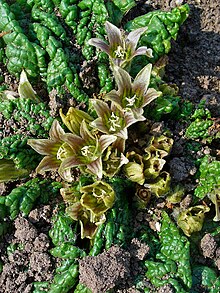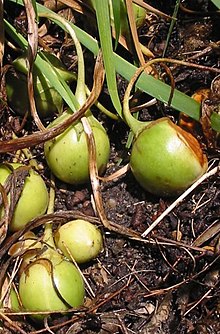Mandrakes
| Mandrakes | ||||||||||||
|---|---|---|---|---|---|---|---|---|---|---|---|---|

Common mandrake ( Mandragora officinarum ) |
||||||||||||
| Systematics | ||||||||||||
|
||||||||||||
| Scientific name | ||||||||||||
| Mandragora | ||||||||||||
| L. |
The mandrake ( Mandragora ) are a genus of plants in the nightshade family (Solanaceae). Of the three species, one occurs in Europe . The common mandrake ( Mandragora officinarum ) is often seen as a ritual and magic plant , primarily due to its cultural history .
description


Vegetative characteristics
Mandrake species are herbaceous plants of several years . Occasionally they give off a foul odor. They are stemless and form a leaf rosette, the diameter of which can be up to 1.5 m. The fleshy, thick tap roots of the mandrake are usually up to 20 cm long, are often forked and are therefore often similar to a human figure.
The simple leaves are ovate to ovate-elongated, mostly 5 to 25 cm long, but the basal leaves can also be up to 80 cm long, they are almost sessile or run down to up to 7 cm long petioles. The upper side of the leaf is wrinkled and blistered; the leaf margin is curved, serrated or wavy.
blossoms
The flowers stand individually in the leaf axils in the middle of the leaf rosette, occasionally they are pendulous. The flower stalks are 2 to over 7 cm long.
The hermaphroditic flowers are radial symmetry and five-fold with a double flower envelope . The five mostly 8 to 18 (5 to 20) mm long sepals are fused to form a calyx tube that is shorter than the calyx lobes. The calyx-lobes of the same shape are triangular with an elongated pointed upper end. The five petals are fused to one another up to half their length or less and form a 1 to 4 cm long, bell-shaped crown. The color of the crown is greenish-white, yellow, dark purple, purple or blue. The corolla lobes are broad or narrowly triangular or broadly elliptical with a truncated upper end. The corolla tube is a little longer or significantly shorter than the corolla lobes. The stamens are fused with this in the lower half of the crown near the base. The stamens are bent towards the center of the flower and are longer than the anthers. The anthers are usually 3 to 4 (1.5 to 4.5) mm long. The connective tissue is thick and fleshy. The thread-like stylus ends in a cephalic and slightly double-lobed scar .
Fruits and seeds
The juicy berries are spherical with a diameter of mostly 2 to 3 (1.5 to 5) cm or elliptical, occasionally pointed with a length of about 5.5 cm and a width of about 4.5 cm. When fully ripe, they give off a pleasant odor that soon becomes heavy and unpleasant. As the fruit ripens, the calyx enlarges so that it towers above the fruit, but can also remain significantly shorter. The size of the seeds is around 2.5 × 2.2 mm or 4 × 5 mm to 6 × 7 mm, depending on the species.
distribution
Mandrakes are common throughout the Mediterranean and across Central Asia to the Himalayas .
Systematics
The genus Mandragora was established by Carl von Linné .
The genus Mandragora consists of three species:
- Himalayan mandrake ( Mandragora caulescens C.B. Clarke )
- Common mandrake ( Mandragora officinarum L. )
- Turkmen mandrake ( Mandragora turcomanica Mizgir. )
The autumn mandrake ( Mandragora autumnalis Bertol. ), Which has long been regarded as an independent species, is only used as a synonym for the common mandrake ( Mandragora officinarum , synonym: "Mandragora vernalis") in recent literature .
Use and ingredients
In Golestan , Iran, the aromatic leaves and berries of the Turkmen mandrake are used as food. However, it should be noted that all parts of the mandrake are very poisonous. The consumption or consumption of only small amounts can result in death from respiratory paralysis.
The toxic effect is caused by the alkaloids hyoscyamine (converts to atropine when isolated ) and scopolamine .
See also
literature
- Stefan Ungricht, Sandra Knapp, John R. Press: A revision of the genus Mandragora (Solanaceae). In: Bulletin of the Natural History Museum. Botany series. Volume 28, No. 1, 1998, pp. 17-40 ( online ).
- Zhi-Yun Zhang, Anmin Lu, William G. D'Arcy: Mandragora. In: Wu Zheng-yi, Peter H. Raven (Ed.): Flora of China . tape 17 : Verbenaceae through Solanaceae . Science Press / Missouri Botanical Garden Press, Beijing / St. Louis 1994, ISBN 0-915279-24-X , pp. 329 (English, online - PDF file ).
- M. Wentzel: About the chemical components of the mandragora root. Dissertation, Berlin 1900.
Individual evidence
- ↑ a b c d e Armando T. Hunziker: The Genera of Solanaceae. ARG Gantner, Ruggell, Liechtenstein 2001, ISBN 3-904144-77-4 , pp. 143-147.